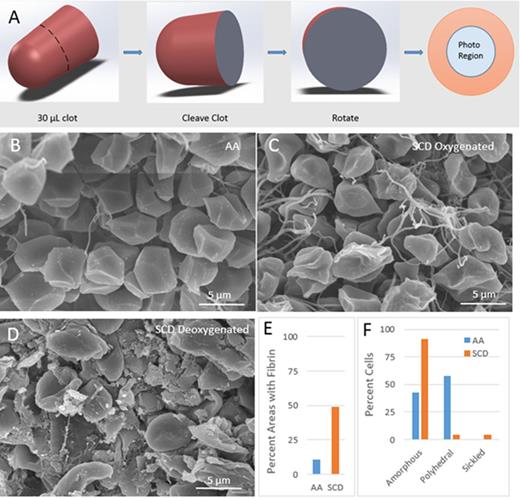Abstract
Background: The genetic mutation of sickle cell disease (SCD) leads to polymerized hemoglobin, causing altered erythrocyte shape, increased stiffness, and dehydration, all of which are associated with vascular occlusion and negative clinical outcomes (Bartolucci, Blood, 2012). Stroke in SCD is a major cause of mortality and morbidity (Bernaudin, Blood, 2011), but little is known about the underlying mechanisms. Recently, in vivo arterial thrombi were noted to comprise a core of tightly packed, polyhedral shaped erythrocytes formed during platelet-mediated clot contraction (Cines 2014). Such a core would likely be altered in SCD due to the altered shape and increased stiffness of SCD erythrocytes causing altered clot mechanics, with important implications in clot dissolution, thromboembolism, and cerebral infarct. Here we present initial data indicating that the unique shape and stiffness of SCD erythrocytes greatly affects the packing and fibrin density in the erythrocyte core of SCD clots.
Results: We examined clots in oxygenated conditions from healthy individuals (AA hemoglobin genotype) and SCD patients not on hydroxyurea under oxygenated and deoxygenated conditions (SS hemoglobin genotype). Within 12 hours of collection for each sample, thirty microliters of citrated blood were recalcified and clotted with 1U/mL thrombin. After one hour, clots are extensively washed in a sodium cacodyl buffer, fixed in 2% glutaraldehyde, dehydrated, cleaved (Fig 1A), and imaged using scanning electron microscopy (Fig 1B-D). Fibrin density was quantified by dividing SEM images into 399 individual regions of equal size and recording either a presence or absence of fibrin in each region (Fig 1E). Red cell type percentage was quantified by distinguishing three cell types (amorphous, polyhedral, and sickled) and counting the number of each cell type present in a given image (Fig 1F). Red cells from AA individuals had the same polyhedral shape as previously observed (Fig 1B). In SCD (Fig 1C), fibrin is much more abundant, and present in nearly 50% of the image vs 10% for AA cells (Fig 1E). In SCD, the planar and smooth polyhedral sides of packed erythrocytes is less pronounced, and many of the cells have a more rounded or amorphous appearance, with very few cells displaying the classic polyhedral shape (4%) (Fig 1F). In deoxygenated conditions the erythrocytes appear more elongated, presumably due to increased polymerization of sickle hemoglobin. We also observe situations where a sickled erythrocyte is completely enveloped by a neighboring erythrocyte, indicating a high degree of heterogeneity in deoxygenated conditions. Finally, unlike AA erythrocytes, SCD erythrocytes do not appear to share common geometrical boundaries indicating a lower packing density
Conclusions and Ongoing Efforts: Taken together, the altered packing density, amorphous shape, and higher fibrin content could play a pivotal role in thromboembolism. As SCD erythrocytes have a higher variance in mechanical stiffness as compared to normal erythrocytes, the heterogeneous packing density and increased fibrin content in SCD clots under physiologically flow conditions could potentially cause weaker parts of the clot to break apart in large, stiff cellular aggregates, contributing to thromboemboli that lead to microvascular occlusion or stroke. Whereas the extra fibrin stabilizes some portions of the clot, the heterogeneous packing could lead to microfissures which destabilize other portions of the clot. Other complementary work such as microfluidic experiments to measure stability and embolic tendency of SCD clots under flow as well as mechanical measurements of SCD clots are currently ongoing.
No relevant conflicts of interest to declare.
Author notes
Asterisk with author names denotes non-ASH members.


This feature is available to Subscribers Only
Sign In or Create an Account Close Modal